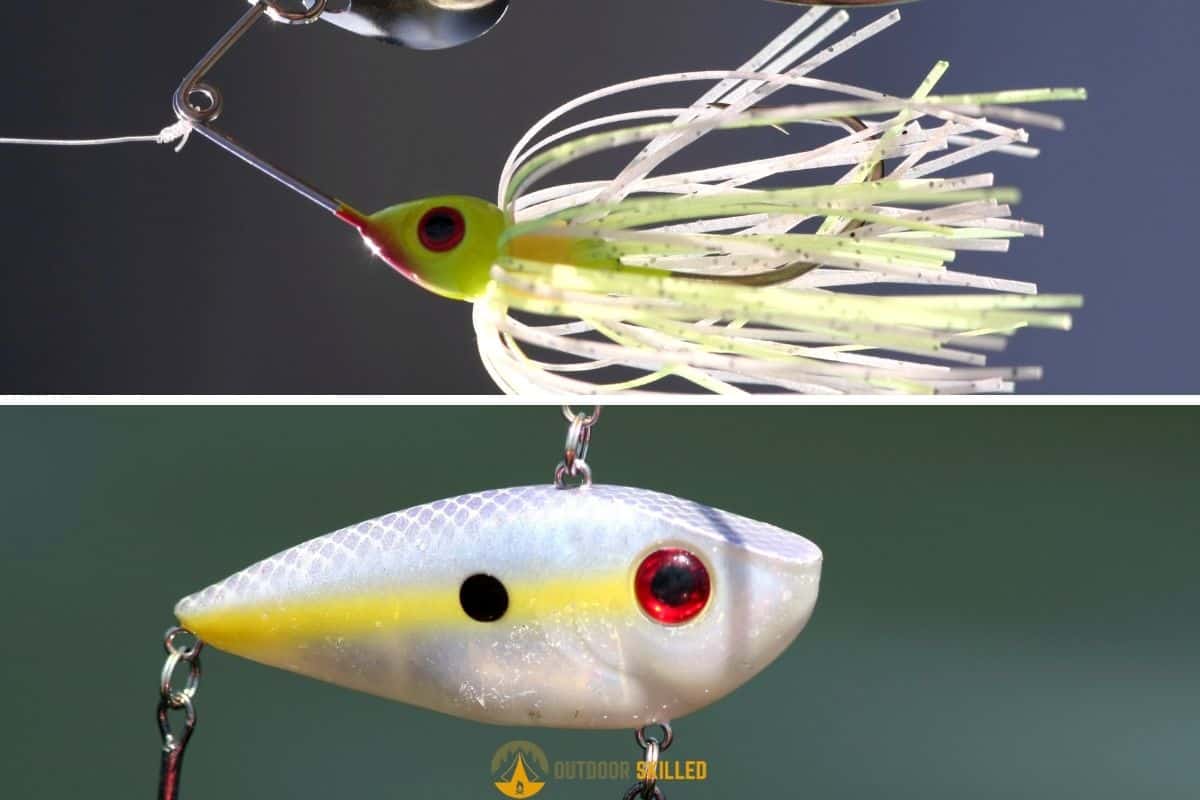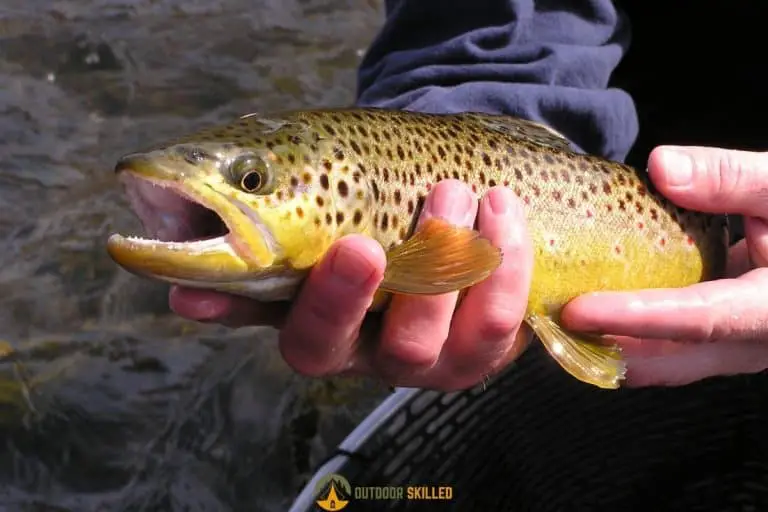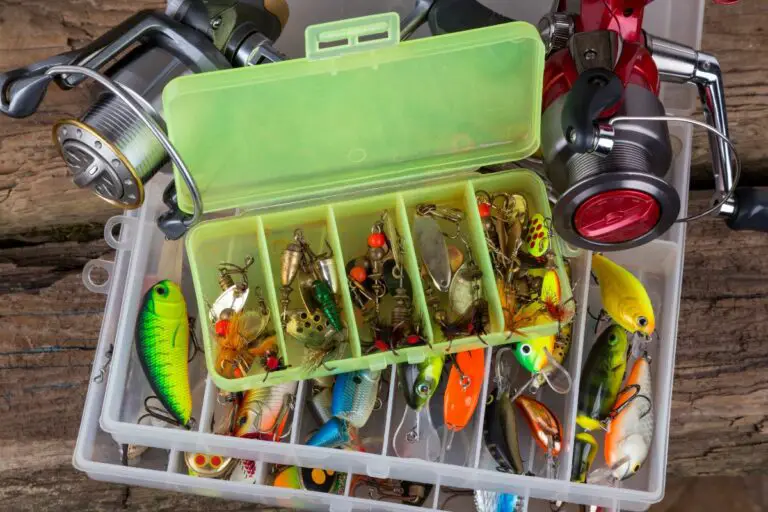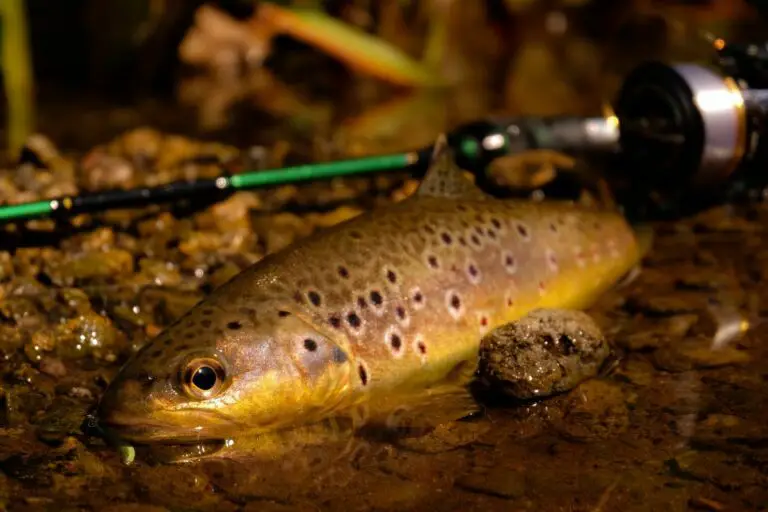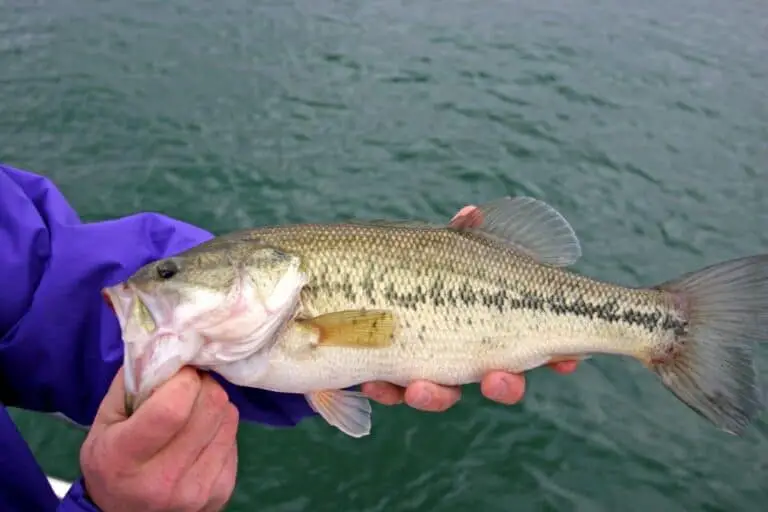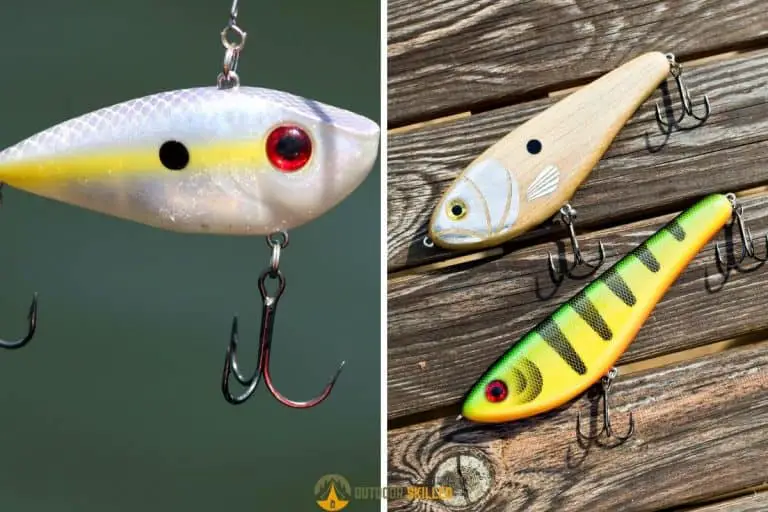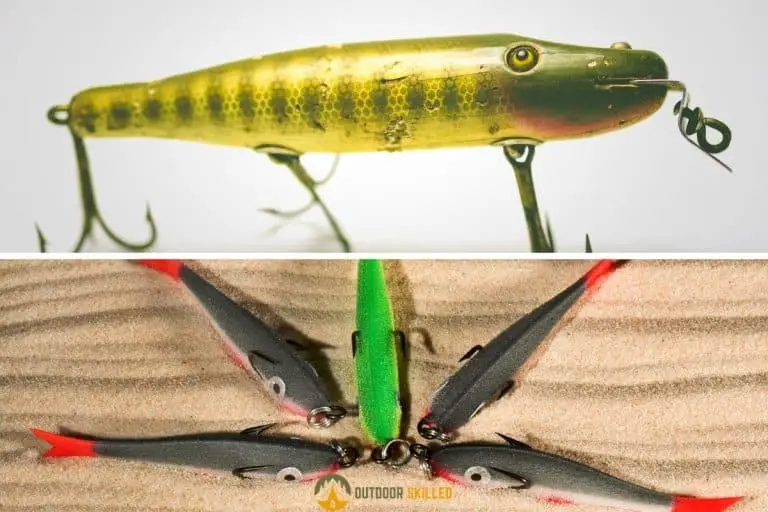Crankbait vs Spinnerbait Full (and Helpful) Comparison
Crankbait and spinnerbait are both versatile and productive lures that can be used anywhere anytime. You can have them both in your tackle box to ensure multiple strikes. However, the differences between them can be vital in choosing which one is the best for the situation.
So, what’s the difference between crankbait and spinnerbait? The difference between crankbait and spinnerbait is that crankbait imitates fish forage while spinnerbait has blades that are responsible for flash and vibration to attract fish. Crankbait is mostly short and wide-bodied while spinnerbait is long and thin.
That’s the short version, for the longer and actually helpful version, let’s dive in this crankbait vs spinnerbait full comparison, shall we?
Table of Contents
What is crankbait?

Crankbait is a type of fishing lure made of hard plastic or wood carving. It’s designed to look like a baitfish, crayfish, or other prey swimming. There are two main categories of crankbait:
- Lipped Or Billed Crankbaits
- Lipless Crankbaits
Each one of these types is designed to do a different job making it ideal for lots of fishing scenarios.
Lipped crankbaits is the popular type and it’s usually called just crankbait. The “lips” stands for that plastic or metal bill at the front. The bill is in the shape of a scoop. It’s normally made of clear plastic and resembles a spoon scoop.
This lip is the one responsible for making the crankbait dive underwater. The bill creates resistance and drags the bait underwater while you crank the reel. Some anglers use weights on their crankbaits to help them suspend.
Lipless crankbaits don’t have the lip at the front. Therefore, they are built to sink. They are weighed down by internal parts that resemble a rattle, which attracts predators due to its noise. Lipless crankbaits are often referred to as rattle baits because of this.
Lipless crankbaits are usually fished faster than lipped crankbaits. They have a tighter wobble, which is ideal for quicker retrievals. Unlike a lipped crankbait, their hook is attached to the top of the lure rather than the front.
What is spinnerbait?

A spinnerbait is any kind of fishing lure that has one or more metal blades that turn like a propeller when the lure is in motion, producing varying degrees of flash and vibration that resemble small fish or other prey.
Spinnerbaits can be used all year round in open waters and are primarily used to catch predatory fish such as perch, pike, and bass. They are particularly useful as a search bait, it helps to attract fish as you begin your day on the lake.
Spinnerbaits come in many different styles. Each style of spinnerbait features some sort of rotating blades that come in a variety of shapes, sizes, materials, colors, and textures as well. The four main types include:
- in-line spinners
They have a single blade, or several blades, that rotate around the bait’s central wire or axis.
- tail spinners
They have a weight-forward design in which the lure’s body or weight, the line tie, and a treble hook are at the very front of the bait and the spinner blade stretches off the back of the bait with a swivel.
- beetle spins
It includes a small jig head attached to an L-shaped wire arm. At the far end of the wire arm, there is a single blade that is attached to the wire with a swivel, allowing the blade to spin while it is pulled through the water.
- live bait spinners
They are basically an extended harness with single or multiple rotating spinner blades, colored beads, and single or multiple baited hooks.
Depending on how it may be fished, the rig can be set up with a weight-forward model for casting and retrieving the rig, or with a weight-down design, such as connecting the rig to a sliding sinker rig or bottom bouncer weight.
Body types
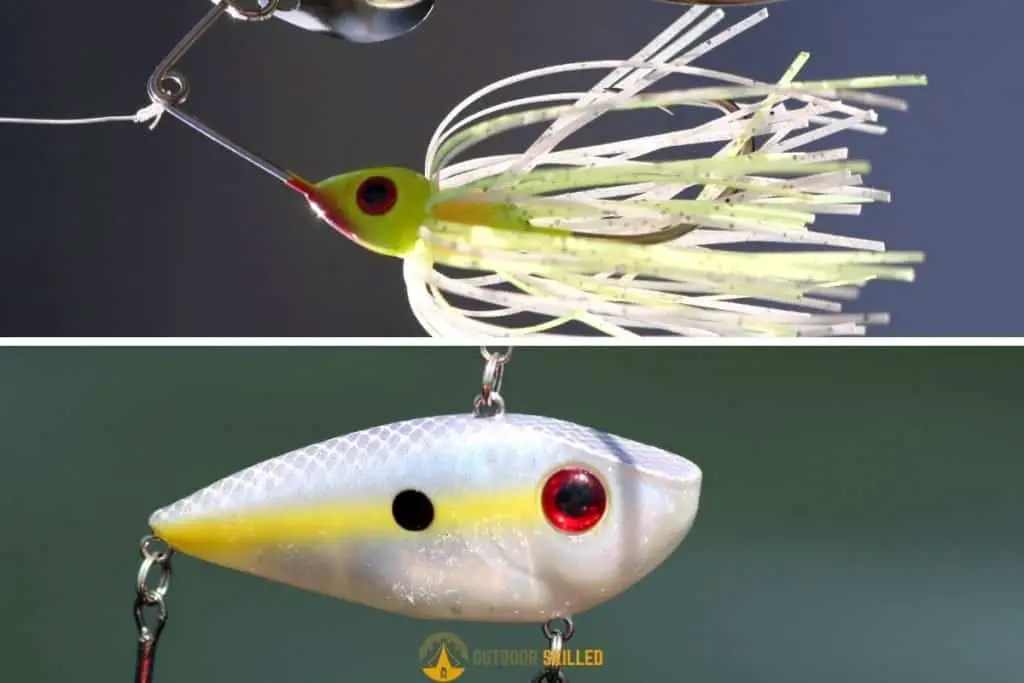
Crankbaits have a frame that is wider and longer. While spinnerbait physique comes from the blade shape itself. For example, Willow Leaf blades are longer and have a slender shape. Colorado blades are the complete opposite with a round shape. Indiana blades stand in between with a teardrop shape.
The width of the bait is an important factor in deciding the body type. When the water temperature is cold, the thin slender profiles of willow leaf spinnerbait have less water displacement and are more subtle, which is desirable. Lipless crankbaits are also great when water temperatures are low.
Retrieval depths
As mentioned before, a crankbait wider and shorter body allows it to sink to various depths. Bill size and shape determine the depth as well, and since crankbaits come in a range of bill sizes and forms, you can choose the best one for the job.
Crankbaits are best used in lakes and deep rivers and reservoirs since most of them are made to dive up to 25 feet or more (7.6 meters).
While spinnerbaits are mostly thrown in 10 feet (3 meters) of water or less, maybe even shallower than that; 2-to-5 feet (0.6-to-1.5 meters). Despite having an uncovered hook, spinnerbaits are practically weedless and less likely to get entangled in the cover you’re throwing in and around.
Lipless crankbaits are a great option if you want the best of both worlds. A lipless crankbait is a shallow diving bait with the movement and the various appearance of a crankbait.
Swimming Actions (with different Scenarios)
In Deep Waters
Lakes and deeper waters are prime locations to use crankbaits. When it moves across the water, the crankbait wobbles. Predatory fish pay close attention to and respond to this wobbling.
When you drag the lure into the water, it starts to dive until it can no longer dive. Buoyancy and upward resistance typically determine this point. The line you’re using will affect upward resistance as well:
- Braided line floats. This will make it put much more upward resistance on a crankbait.
- Fluorocarbon line sinks. It will allow a crankbait to reach its maximum depth.
Crankbaits can travel at the same depth for a limited time until reaching their maximum depth. It will then begin to rise to the surface and eventually hit your rod tip.
Even though spinnerbaits are popular as shallow bait, but they can still produce in deeper waters. They are excellent to throw on deep main lake points, over brush piles, submerged logs, and other structures to get suspended fish without getting snagged.
Since spinnerbait flashes and vibrates, it’s ideal for deeper waters where fish can’t detect your lure. The flash will stand out and the vibrations they produce from motion helps fish to follow them from a mile away.
In Shallow Waters
In shallow waters such as ponds and creeks, spinnerbaits are ideal. They are useful to throw when there is current in a body of water, such as a river or reservoir, or when there is some water flow, such as wind and waves on a lake.
A lipless crankbait can be your best bet here as well. If your crankbait floats, retrieving it for a spool turn or two and letting it float back to the surface is a safe way. If your crankbait sinks, the only way to avoid being snagged is to carefully retrieve it to the bank.
How to fish a crankbait?
There are various ways to fish a crankbait as well. Let’s take a look at these approaches:
Reel and pause
Pausing for a few seconds between retrieves will help you catch more fish, whether you’re fishing with floating or sinking crankbaits. It will provide the required pause in retrieval for fish to catch up and hit. Crankbaits that float will make their way back to the surface, and those that suspend or sink will rest in place or sink steadily.
Touching bottom
To touch bottom with a crankbait, You’ll need a crankbait that sinks lower than the depth of the water you’re fishing in. For instance, if you’re fishing in 5 feet (1.5 meters) of water, a 10 feet diving crankbait will serve. That’s why this method requires more experience and can be frustrating for beginners.
Mud will be whipped by the crankbait hitting the ground and floating over it, potentially resulting in further strikes from your target fish.
Strong retrieval
From its name, this method is perfect for shaking up the crankbait’s swimming action. Pull the rod back sideways quickly, reel in the slack, and repeat instead of reeling in the crankbait at a slow action. This leads the crankbait to swim erratically, stop, and then swim erratically again.
How to Fish a spinnerbait?
Some anglers like to use their spinnerbait in one way, which is adding some sort of erratic movement to the bait by twitching the rod. However, spinnerbait can generate far better results if worked differently.
Slow-Roll
This is mostly used in deep waters or winter fishing in general. When a fish is suspended fairly deep over drop-offs or underwater cover, throw into deeper water, point the rod tip down, and retrieve very slowly, barely quick enough to spin the blades so the lure sinks as it swims.
Contact
In this approach, you cast well past your target and retrieve the spinnerbait slowly. Try to hit the lure against the stump, brush, or grass where you’re fishing. This subtly changes the course and action of the bait and sometimes results in a strike.
Buzz
This is particularly used in murky, shallow water. What you need to do is to create a splash around. Reel quickly with the rod tip held high and let the blades of the bait break the surface.
Wake
This is also used for murky shallow water. Cast past a logjam or other heavy cover and immediately raise the rod tip high and reel quickly. The spinnerbait would rise to the top of the water but unlike buzz, you don’t break the water.
Helicopter
Allow the lure to fall to the bottom on a tight line while fishing steep banks, ledges, or drop-offs. When the bait falls, the spinner blade will rotate. When it reaches the bottom, reel up the slack, slightly lift the rod tip, and lower it again. Repeat till you get a strike.
Now that you know all about Crankbait and Spinnerbait, let’s get to know another lure type. Check out this (also helpful) Crankbait VS Jerkbait comparison here.
Related Questions
What Fish Get Drawn To Crankbait?
Lots of fish species get drawn to crankbait. Species such as trout, salmon, bass, pike, walleye, perch, and panfish. They come in different sizes and colors making them ideal to match any fish’s forage.
Which blade color to use in spinnerbaits?
The blade color of spinnerbait depends on where you’re fishing. Silver blades are favorable in clear water and gold or copper blades in murky water. To minimize flash, clear and shallow water requires the use of white blades.
Helpful Resources
Retrieving depth of crank bait lure controlled by tied-eye position
Change in diving behavior by lip shape and tied-eye position of crank bait lure [2001]
If you like this article, please share it or pin it, you can find the share buttons below. We will really appreciate it ❤️

